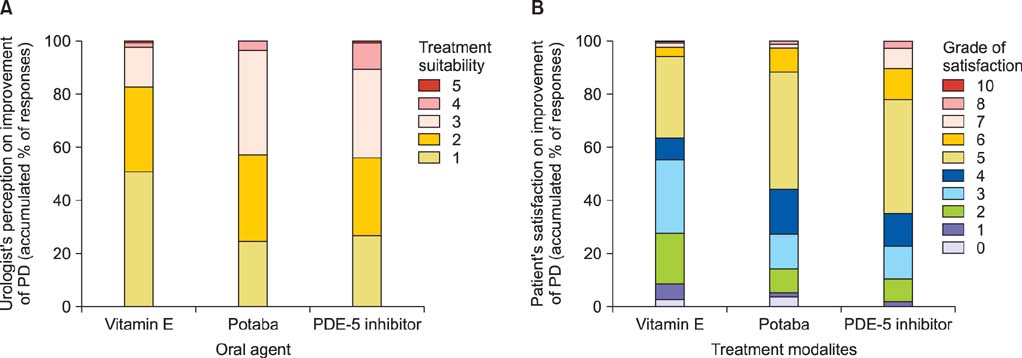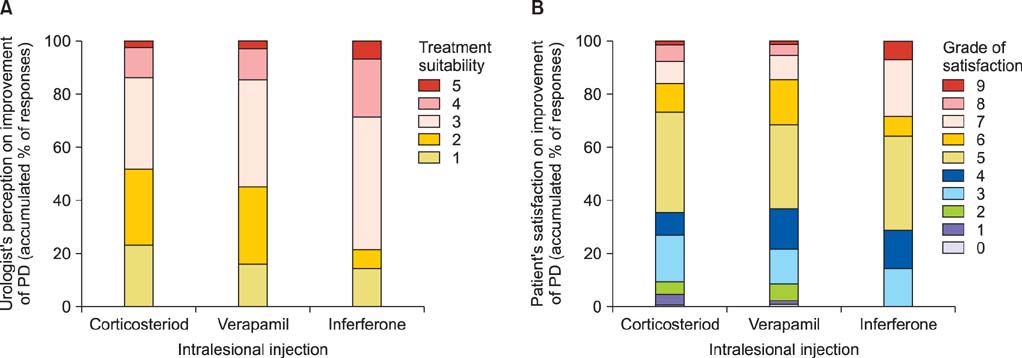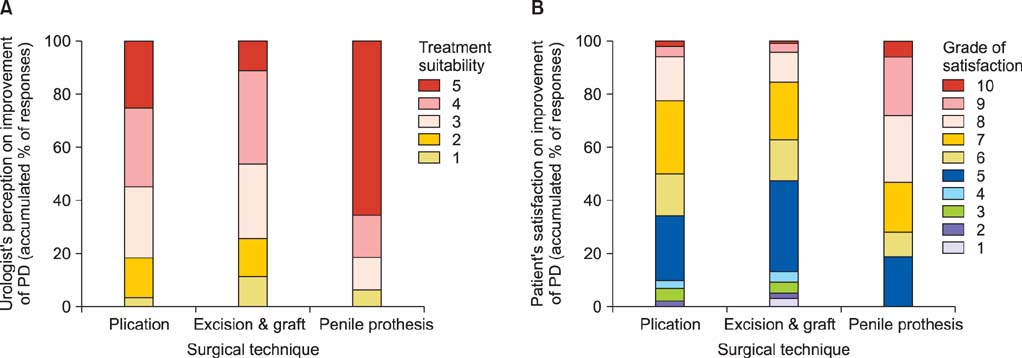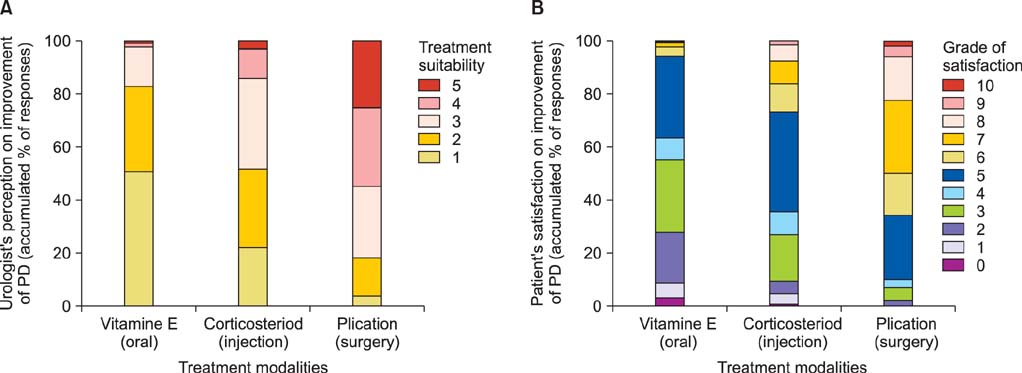Korean J Urol.
2014 Jan;55(1):57-63. 10.4111/kju.2014.55.1.57.
Urologists' Perceptions and Practice Patterns in Peyronie's Disease: A Korean Nationwide Survey Including Patient Satisfaction
- Affiliations
-
- 1Department of Urology, Yeungnam University College of Medicine, Daegu, Korea.
- 2Department of Urology, Samsung Medical Center, Sungkyunkwan University School of Medicine, Seoul, Korea.
- 3Department of Urology, The Catholic University of Korea College of Medicine, Seoul, Korea.
- 4Department of Urology, Hallym University College of Medicine, Chuncheon, Korea.
- 5Department of Urology, Korea University College of Medicine, Seoul, Korea.
- 6Department of Urology, Ewha Womans University School of Medicine, Seoul, Korea.
- 7Department of Urology, Chonnam National University Medical School, Gwangju, Korea. uropark@gmail.com
- 8Department of Urology, Gyeongsang National University School of Medicine, Jinju, Korea.
- 9Department of Urology, Inha University School of Medicine, Incheon, Korea.
- 10Department of Urology, Busan National University School of Medicine, Yangsan, Korea.
- KMID: 1988454
- DOI: http://doi.org/10.4111/kju.2014.55.1.57
Abstract
- PURPOSE
A nationwide survey was conducted of Korean urologists to illustrate physicians' perceptions and real practical patterns regarding Peyronie disease (PD).
MATERIALS AND METHODS
A specially designed questionnaire exploring practice characteristics and attitudes regarding PD, as well as patient satisfaction with each treatment modality, was e-mailed to 2,421 randomly selected urologists.
RESULTS
Responses were received from 385 practicing urologists (15.9%) with a median time after certification as an urologist of 12 years. Regarding the natural course, 87% of respondents believed that PD is a progressive disease, and 82% replied that spontaneous healing in PD occurred in fewer than 20% of patients. Regarding diagnosis of PD, the methods used were, in order, history taking with physical examination (98%), International Index of Erectile Function questionnaires (40%), intracavernous injection and stimulation (35%), and duplex sonography (28%). Vitamin E was most preferred as an initial medical management (80.2%), followed by phosphodiesterase-5 inhibitors (27.4%) and Potaba (aminobenzoate potassium, 20.1%). For urologists who administered intralesional injection, the injected agent was, in order, corticosteroid (72.2%), verapamil (45.1%), and interferon (3.2%). The most frequently performed surgical procedure was plication (84.1%), followed by excision and graft (42.9%) and penile prosthesis implantation (14.2%). Among the most popular treatments in each modality, the urologists' perceptions regarding the suitability of treatment and patient satisfaction were significantly different, favoring plication surgery.
CONCLUSIONS
The practice pattern of urologists depicted in this survey is in line with currently available Western guidelines, which indicates the need for development of further local guidelines based on solid clinical data.
Keyword
MeSH Terms
-
4-Aminobenzoic Acid
Certification
Cyclic Nucleotide Phosphodiesterases, Type 5
Data Collection
Diagnosis
Electronic Mail
Humans
Injections, Intralesional
Interferons
Male
Patient Satisfaction*
Penile Implantation
Penile Induration*
Physical Examination
Potassium
Questionnaires
Transplants
Verapamil
Vitamin E
Vitamins
4-Aminobenzoic Acid
Cyclic Nucleotide Phosphodiesterases, Type 5
Interferons
Potassium
Verapamil
Vitamin E
Vitamins
Figure
Cited by 1 articles
-
Nonsurgical Interventions for Peyronie's Disease: Update as of 2016
Gregory A Joice, Arthur L Burnett
World J Mens Health. 2016;34(2):65-72. doi: 10.5534/wjmh.2016.34.2.65.
Reference
-
1. Taylor FL, Levine LA. Peyronie's disease. Urol Clin North Am. 2007; 34:517–534.2. Jarow JP, Lowe FC. Penile trauma: an etiologic factor in Peyronie's disease and erectile dysfunction. J Urol. 1997; 158:1388–1390.3. Devine CJ Jr, Somers KD, Jordan SG, Schlossberg SM. Proposal: trauma as the cause of the Peyronie's lesion. J Urol. 1997; 157:285–290.4. Gelbard MK, Dorey F, James K. The natural history of Peyronie's disease. J Urol. 1990; 144:1376–1379.5. Mulhall JP, Schiff J, Guhring P. An analysis of the natural history of Peyronie's disease. J Urol. 2006; 175:2115–2118.6. Kadioglu A, Sanli O, Akman T, Canguven O, Aydin M, Akbulut F, et al. Factors affecting the degree of penile deformity in Peyronie disease: an analysis of 1001 patients. J Androl. 2011; 32:502–508.7. Hatzimouratidis K, Eardley I, Giuliano F, Hatzichristou D, Moncada I, Salonia A, et al. EAU guidelines on penile curvature. Eur Urol. 2012; 62:543–552.8. Muller A, Mulhall JP. Peyronie's disease intervention trials: methodological challenges and issues. J Sex Med. 2009; 6:848–861.9. El-Sakka AI, Yassin AA. Conservative treatment for Peyronie's disease: an update. Expert Opin Pharmacother. 2008; 9:53–63.10. Levine LA, Newell M, Taylor FL. Penile traction therapy for treatment of Peyronie's disease: a single-center pilot study. J Sex Med. 2008; 5:1468–1473.11. Gontero P, Di Marco M, Giubilei G, Bartoletti R, Pappagallo G, Tizzani A, et al. Use of penile extender device in the treatment of penile curvature as a result of Peyronie's disease Results of a phase II prospective study. J Sex Med. 2009; 6:558–566.12. LaRochelle JC, Levine LA. A Survey of primary-care physicians and urologists regarding Peyronie's disease. J Sex Med. 2007; 4(4 Pt 2):1167–1173.13. Schwarzer U, Sommer F, Klotz T, Braun M, Reifenrath B, Engelmann U. The prevalence of Peyronie's disease: results of a large survey. BJU Int. 2001; 88:727–730.14. Kadioglu A, Sanli O. Epidemiology of Peyronie's disease. In : Levine LA, editor. Peyronie's disease: a guide to clinical management. Totowa (NJ): Humana Press;2007. p. 9–18.15. Chung E, Clendinning E, Lessard L, Brock G. Five-year follow-up of Peyronie's graft surgery: outcomes and patient satisfaction. J Sex Med. 2011; 8:594–600.16. Benson JS, Abern MR, Levine LA. Penile shortening after radical prostatectomy and Peyronie's surgery. Curr Urol Rep. 2009; 10:468–474.17. Weidner W, Hauck EW, Schnitker J. Peyronie's Disease Study Group of Andrological Group of German Urologists. Potassium paraaminobenzoate (POTABA) in the treatment of Peyronie's disease: a prospective, placebo-controlled, randomized study. Eur Urol. 2005; 47:530–535.18. Pryor JP, Farell CR. Controlled clinical trial of vitamin E in Peyronie's disease. Prog Reprod Biol Med. 1983; 9:41–45.19. Lemourt Oliva M, Filgueiras Lopez E, Rodriguez Barroso A, Gonzalez Oramas E, Bordonado R. Clinical evaluation of the use of propoleum in Peyronie's disease. Arch Esp Urol. 1998; 51:171–176.20. Teloken C, Rhoden EL, Grazziotin TM, Ros CT, Sogari PR, Souto CA. Tamoxifen versus placebo in the treatment of Peyronie's disease. J Urol. 1999; 162:2003–2005.21. Safarinejad MR. Therapeutic effects of colchicine in the management of Peyronie's disease: a randomized double-blind, placebo-controlled study. Int J Impot Res. 2004; 16:238–243.22. Biagiotti G, Cavallini G. Acetyl-L-carnitine vs tamoxifen in the oral therapy of Peyronie's disease: a preliminary report. BJU Int. 2001; 88:63–67.23. Safarinejad MR, Hosseini SY, Kolahi AA. Comparison of vitamin E and propionyl-L-carnitine, separately or in combination, in patients with early chronic Peyronie's disease: a double-blind, placebo controlled, randomized study. J Urol. 2007; 178(4 Pt 1):1398–1403.24. Ryu JK, Suh JK. Peyronie's disease: current medical treatment and future perspectives. Korean J Urol. 2009; 50:527–533.25. Shirazi M, Haghpanah AR, Badiee M, Afrasiabi MA, Haghpanah S. Effect of intralesional verapamil for treatment of Peyronie's disease: a randomized single-blind, placebo-controlled study. Int Urol Nephrol. 2009; 41:467–471.26. Dibenedetti DB, Nguyen D, Zografos L, Ziemiecki R, Zhou X. A population-based study of Peyronie's disease: prevalence and treatment patterns in the United States. Adv Urol. 2011; 2011:282503.27. Nicolosi A, Glasser DB, Kim SC, Marumo K, Laumann EO. GSSAB Investigators' Group. Sexual behaviour and dysfunction and help-seeking patterns in adults aged 40-80 years in the urban population of Asian countries. BJU Int. 2005; 95:609–614.
- Full Text Links
- Actions
-
Cited
- CITED
-
- Close
- Share
- Similar articles
-
- Korean Urologist's View of Practice Patterns in Diagnosis and Management of Benign Prostatic Hyperplasia: A Nationwide Survey
- Comprehension and Practice Patterns of Korean Urologists for Retractile and Gliding Testes
- Two cases of Peyronie's disease treated by auto-dermal graft technique
- The Relationship between Perceptions of Nursing College Students regarding Clinical Practice Environment and Related Variables
- Chinese Urologists' Views of Practice Patterns in the Diagnosis and Treatment of Benign Prostatic Hyperplasia: A Nationwide Survey





